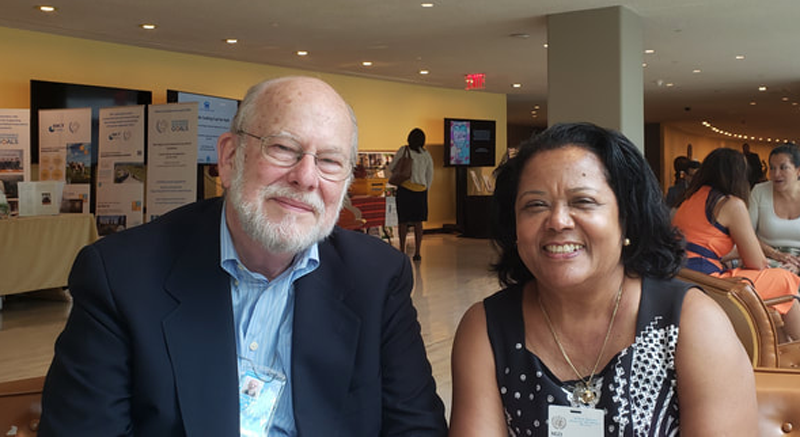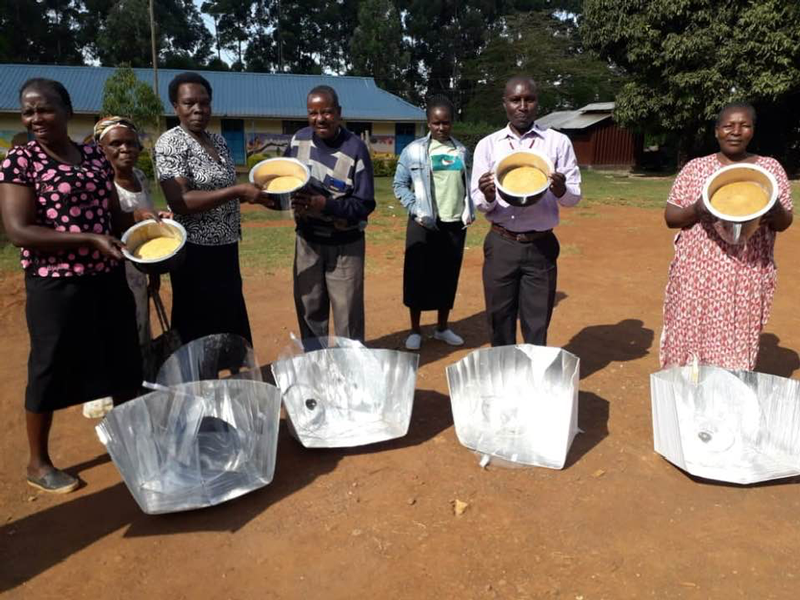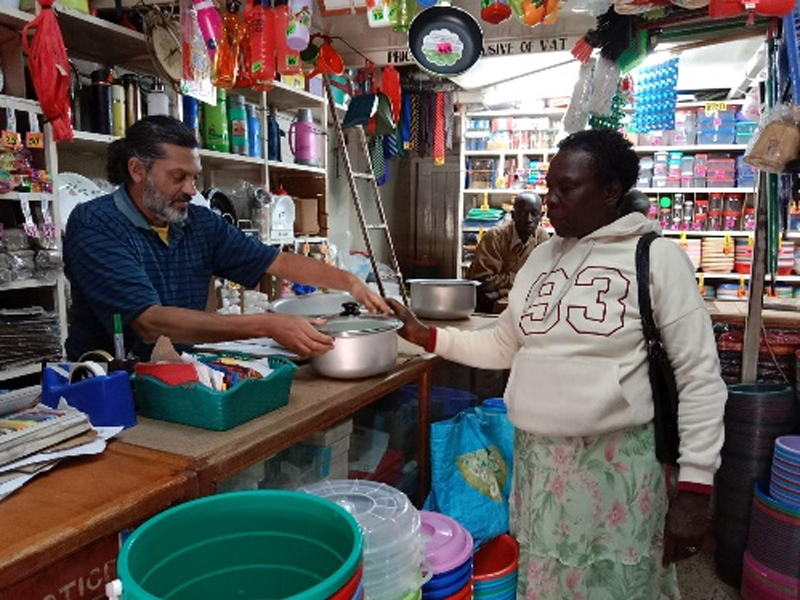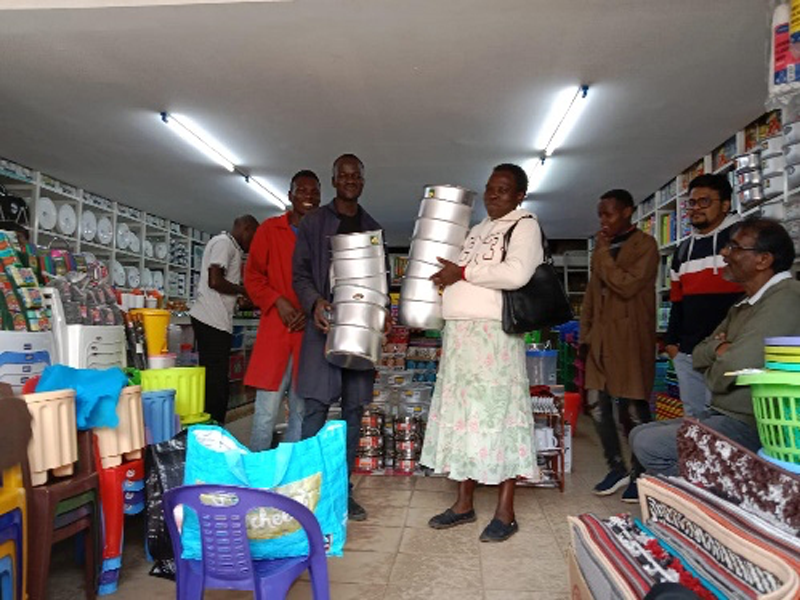Everybody cooks. Whether using World Health Organization-designated “clean fuels” – electricity, biogas, natural gas, liquified petroleum gas (LPG), solar or alcohol – or “dirty fuels,” such as charcoal, kerosene, biomass or wood, most basic foods must be heated to be edible. Globally, 2.4 billion people lack access to clean cooking. As a result, 3.2 million people die every year from indoor air pollution caused by burning “dirty fuels” in their homes. These premature deaths strike rural residents hardest; 52 percent of them rely on dirty fuel.
Solar cooking is carbon-free and can be implemented relatively quickly in supply chain challenged locations. However, the current adoption of solar cookers as primary cooking equipment is still very limited. Several dedicated and dispersed nonprofits are trying to change that in order to improve the lives of people living in some of the most difficult locations on earth.
The Public-Private Alliance Foundation (PPAF) has supported clean cooking in Haiti since 2012, and implemented solar cooking in 2018. “Our Haitian-American colleague Rose Bazile and her team created the first college course in Haiti on solar cooking and biodigesters at the University Notre Dame d’Haiti,” says David Stillman, executive director of PPAF. “By teaching seminars, testing and demonstrating solar cooking in the cities of Hinche, Jacmel and Cotes de Fer, Rose’s team promotes solar cooking in Haiti.” PPAF has deployed 150 cookers to date.

PPAF uses the Haines 2.0, which positions a black cooking pot with a tight-fitting glass lid inside a flexible mylar foam reflector that folds into a package the size of a yoga mat. “The Haines is simple, collapsible, powerful and fairly durable,” Stillman says. “People use it to prepare a wide variety of beans, rice, soups, stews and eggs.” Stillman estimates demand for solar cookers exceeds 10,000 units and aims to encourage small businesses to achieve this.
The large majority of Haitian families rely on charcoal for cooking their daily meals, which accelerates deforestation and associated environmental problems such as landslides. Charcoal is expensive and disproportionately burdens local families’ income. PPAF’s local team has requested many more solar cookers because the demand is high. Stillman credits Bazile with PPAF’s success and, as a next step, aims to encourage local businesses to build and sell solar cookers. (See sidebar for the solar cooker recipe for Soup Joumou, which is traditionally served on Haitian National Day.)
Grace Chepkemei reports that solar cookers have been similarly well received in Eldoret, Kenya. In a project jointly sponsored by the Rotary Club of San Diego, Solar Household Energy, the Solar Energy Project, and Haines Solar Cookers LLC, twenty members of the St. Joseph Church enrolled in a seven-day solar cooking workshop.
Before the workshop, Chepkemei reported that the main cooking fuels in the area were firewood and charcoal, often illegally sourced from the forest. To prepare for the workshop, and to keep costs down, only the flexible solar panels of the Haines cookers were imported. Suitable local pots were found and painted black with fireproof paint. The glass lids, essential for the focused sunlight to reach the food, were also sourced locally.

By the end of the course, “All participants cooked various foods and baked bread and cakes in front of the church and so many parishioners viewed and tested the food. They were amazed at the wonders of the sun and the Haines cooker. Many insisted that they too should be trained on solar cooking. We are happy that we now have 20 trainers who can go to different places to train,” says Chepkemi.
In Oaxaca, Mexico, a third small group of solar cooking pioneers is led by Lorena Harp. The “Mujeres del Sol” train indigenous women on how to cook and preserve food using solar cookers. One student, Villanueva Reyes, says, “At the beginning, it was very strange. We were 20 women learning together. Now I save a lot because I don’t spend on electricity.” Reyes notes that she prepares beans, pumpkin and potatoes in her cooker. Reyes provides a sobering reminder that even basic hygiene costs money. “The pot doesn’t get smoky, so you don’t use much soap.”

These projects have one man in common: Roger Haines. Following a 29-year career as an assistant U.S. attorney, Haines became interested in solar cooking. Already active with the San Diego Rotary Club (co-chair International Projects) and the Alliance for African Assistance (a refugee resettlement organization), a 2013 conversation between Haines and a newly-arrived Ugandan refugee inspired Haines to design his first solar cooker.
“Over 4,000 cookers have been sold online so far, and the sustainability organization Treehugger rates the Haines 2.0 as the best overall solar cooker of 2023,” Haines says. “We are scaling up to meet demand. We partner with NGOs and entrepreneurs to make cookers more available in developing countries. Scale-up costs are high and challenging.”

Tireless, Haines serves on the board of Solar Household Energy, a Washington, D.C. nonprofit. And in his “spare” time, he recently co-authored Federal Sentencing Guidelines Handbook, 2022-2023 edition.
Solar cooking is not perfect. On rainy or cloudy days, a backup fuel must be used to cook. Still, “In locations like the Sahel region of Africa, or India, or Central America, solar meets the needs of families a very large percentage of the time,” says Executive Director of Solar Cookers International (SCI) Caitlyn Hughes. SCI’s leadership through advocacy, best practices capacity building, and research on measuring the power of solar cooking products resulted in the organization being named a Keeling Curve Prize Laureate in 2021.
“Over four million solar cookers are currently in use worldwide, preventing over 5.8 million metric tons of CO2 emissions each year,” says Hughes. “This is the equivalent of taking 1.25 million cars off the road. Solar cookers can boil water. In fact, at the Muni Sera Ashram in Gujarat, India, solar hot water is used on an institutional scale. SCI held our 2018 solar cooking conference at Muni Sera Ashram because we wanted our 200 guests to witness the parabolic and box cookers that produce food and clean water for hundreds of students and residents every day.”

SCI calculates and publishes the costs and potential impact of solar cooking by country. For example, in Mexico, household air pollution kills 15,680 people prematurely every year. Approximately 19.7 million Mexicans rely on dirty cooking fuels. If these households deployed solar cooking 25 percent of the time, SCI’s model projects annual savings of $8.2 billion in energy, environmental and health costs. The potential impact of solar is demonstrated by SCI in country after country: Nepal – $2.6 billion. Haiti – $931 million.
Clean cooking covers a range of alternatives that help truly disadvantaged families achieve a better and healthier standard of living. Thanks to the work of PPAF, Haines, SHE, SCI and the many volunteer organizations bringing this technology to last-mile communities, carbon-free solar cooking is growing in use. In the words of Grace Chepkemi, “I believe this is the beginning of a great journey.”
Headline Photo: Nepal Sanu Kaji Shrestha – Nawajeevan.
Soupe Joumou
Ingredients
- ½ Large Joumou (Giromon squash)
- 5 Carrots
- 2 Yams
- 4 Malangas
- 1 Small Cabbage
- 3 Leeks
- 2 Militons
- 2 Turnips
- Some Goat meat
- 1 Small Bag of Macaroni
- Spice
- Maggi powder
- Butter
- Salt
Time: 3hr 51 min
Serves: 4 persons
Directions
- Put the water on to heat in the solar cooker.
- Wash and peel the vegetables.
- Cut the vegetables and goat meat into bite size pieces.
- Add joumou to pot and begin cooking.
- Add the rest of the vegetables, goat meat, and pasta to pot along with seasoning.
- Simmer until meat is fully cooked and vegetables and pasta are tender.
- Adjust seasoning to taste.
- Allow the dish to cool before serving.
This is the traditional Haitian dish enjoyed on Independence Day, January 1st!
Elizabeth Wilder is a freelance writer based in Houston, Texas.
Oil and gas operations are commonly found in remote locations far from company headquarters. Now, it's possible to monitor pump operations, collate and analyze seismic data, and track employees around the world from almost anywhere. Whether employees are in the office or in the field, the internet and related applications enable a greater multidirectional flow of information – and control – than ever before.




